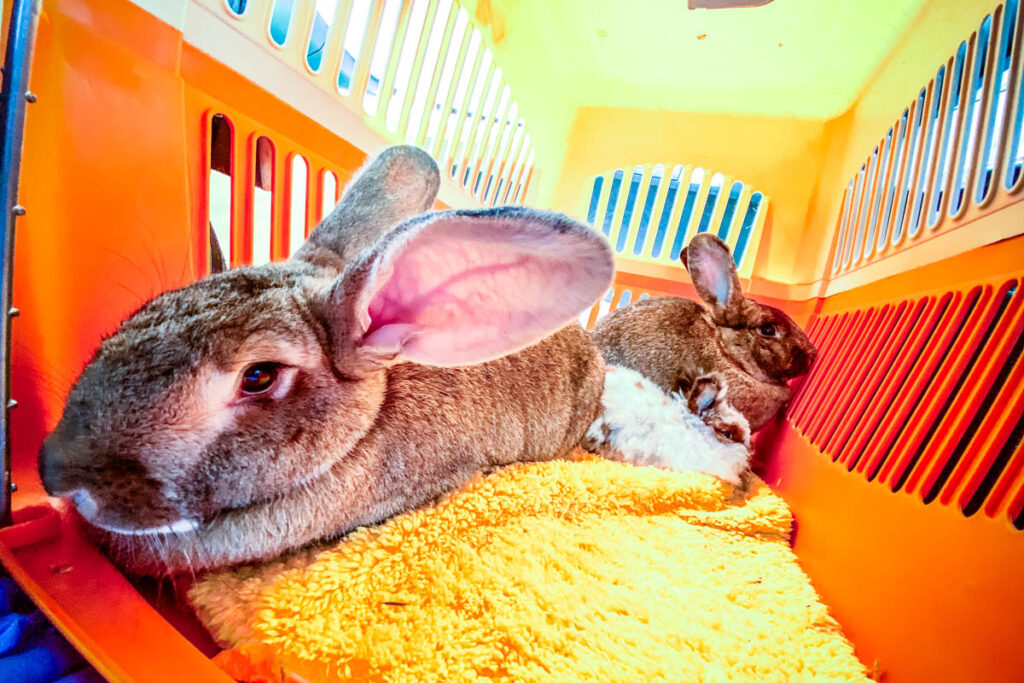Moving day. You’ve thought of everything: packing, hiring the movers, planning your route to your new home, how you’re going to transport your valuables. But what do you do about your most fragile, beloved valuable of all, your house rabbit?
I’ve relocated eight times across several states during my years with rabbits. I’ve driven along sleek smooth highways and gritty dirt roads, into glaring bright mornings and deep velvet nights, every hour spent with my bunnies at my side, and I’m going to share with you a few of the lessons I’ve learned.
The Basics: I Know You Know This, But…
They must travel in the car with you. Don’t put them in a trailer, or anything else just attached to your vehicle. These are your house rabbits; keep them inside the car with you. You should be able to monitor them the entire trip. If it’s hot, they’ll need the air- conditioning. If it’s cold, they’ll need a little heat. And just like in your home, they should be shielded from drafts and extra loud noises.
What if it’s hot and your car doesn’t have air conditioning? Filled, frozen plastic water bottles placed inside each cage. Depending upon the length of your journey, you can prepare a cooler of them before you go.
What if it’s cold and the heat isn’t reaching them? Extra towels or blankets they can snuggle against.
Prep Work: No One Likes Smelly Towels
There’s some debate about traveling with your buns in carriers vs. cages. Several factors can contribute to how you manage it, but usually, it comes down to the space available inside your car. If your trip isn’t a long one, you might consider a carrier instead of a cage. The rabbits will have less room, but you can strap a seatbelt around a carrier a lot more easily than you can a cage. In case of sudden starts or stops, bunny will not be flung as far.
Wire cages can also damage your car’s seats; place a sturdy rug or bathmat beneath them so they don’t. Drape the cage with towels or blankets so that the bunny will feel safer. In either case, surround your rabbits with soft things, especially familiar plush toys or clean towels. Don’t put anything hard (except possibly the frozen water bottle) or with sharp edges inside their traveling environment; again, think about the effects of sudden stops. They have no sure way to steady themselves.
Bring extra towels for them, even more than you think they’ll need, and a sealed container for the soiled ones. They will likely mess up whatever’s beneath them several times during the day, so when you stop to get gas, check. You don’t want your rabbits hunched up on sodden towels all day.
If you’re lodging overnight, a bottle of carpet spot cleaner and a roll of paper towels could come in handy.
Bonded pairs of buns should be kept together. Their journey will be much, much easier with a trusted partner at their side.
Keep single bunnies within view, if possible. You are their rock and the only thing they know in this frightening, shiting new world. Let them realize you’re there with them.
Your rabbits are likely accustomed to grazing during the day, and you definitely want to make sure there is nourishment available to them on the road. I’ve placed pellets in the cages/carriers before, but honestly, I’ve never had a rabbit eat while the car was in motion. So feel free to put some hay in there with them (it’s soft!) but pellets require a bowl, and that can be dangerous. Unless they’re on some sort of emergency diet, I suggest saving the pellets for whenever you’ve stopped for the day.
Do not try to drive with a hanging water bottle attached to a cage. No matter how you position it, it will make a huge mess and soak everything. Have fresh water in bowls ready to offer during temporary stops, but don’t be surprised if your buns don’t drink. They are stressed.
Getting There: It’s All About the Journey
This is going to sound obvious, but don’t drive like a maniac. We’ve all been stuck behind that person puttering along so leisurely that you roll your eyes and grit your teeth and wonder from which particular circle of hell they got their license. You are that person now. Who cares what the people in the cars behind you think? You’ll never see any of them again. Your rabbits are your priority. Take turns slowły. Accelerate gently: decelerate gently. Smile cheerfully at all the angry, rabbit-less people whipping past you. Your blood pressure is going to be so much healthier than theirs.
Some bunnies like music. A lot don’t. Keep things as calm and soothing as you can. No blasting the stereo. If you stop and have to leave the car, don’t be gone long. Remember, as always, that temperature fluctuations in cars are dangerous to all pets.
Should your trip require more than one day on the road, you’ll need to find lodging. Don’t push yourself to drive all night; that’s never safe, and you want to get to your new location all in one piece. Just find a clean, well-lit place to stay and get some rest.
Do not leave your rabbits in your car overnight. Not unless you’re also planning to sleep there with them, which I assume would be an emergency measure. Think about the overnight environment inside your car: strange noises, odd lights, people walking back and forth, maybe rapping on the window because they see a pet inside. The temperature changes, completely beyond your senses or control. And, frankly, what if your car gets broken into, or stolen? If you’re moving, you’ve probably got a lot of stuff crammed in there. Even if you’re not, people are opportunists, and they’ll take what they can find. Do not risk sleeping apart from your rabbits, any more than you would your jewelry or wallet.
Try to find a hotel/motel that has access to the rooms not too near the check-in lobby, and definitely don’t stay at one that requires you to walk through the lobby to get to your room. Happily, hotels/motels with rooms physically apart from the main building aren’t very difficult to locate, especially in the little towns you’re likely to encounter along highways. You want to be able to park as closely as possible to your room and get the buns inside as swiftly as possible. Rabbits are a curiosity to most people, and the less you have to deal with questions from either hotel management or the other guests, the better.
Walk quickly. Act like you know what you’re doing, If people notice you’re carrying rabbits and say anything about it, just smile vaguely and reply something noncommittal (“Why, yes, they are rabbits!” Or, if you’re a smart aleck like I am: “Oh, no, these aren’t real!”). and then get the heck out of the situation.
Why am I suggesting you act like a thief hastening away from the scene of the crime? Because, bluntly, you cannot trust strangers with your bunnies. I’m sorry to say it, but it’s true. Even well-meaning people can accidentally hurt your rabbits by mishandling them. On several occasions, parents who noticed I’m traveling with bunnies have approached and said something like, “Hey, my kid wants to pet/play with your rabbit”—and have gotten belligerent when I declined.
No. The answer is always no. You owe nothing to strangers or their children, at a hotel or anywhere else. You might think it could be a good learning experience for the child, but remember: this is not a normal day for your bun. Your rabbit is delicate, anxious, and totally your responsibility. You need to put her first.
I let my rabbits roam the hotel room while I’m there to watch because I want them to hop around and stretch their legs, and I want them to know the room is safe. (Obviously, if you leave, they should go back into their cages.) The bolder ones usually do explore; the more timid, however, tend to hide in their safe place, unwilling to risk it. That’s okay. too. Remember, this is all just temporary.
Now is the time to ensure they have fresh food and water within reach. They may not eat or drink yet, but overnight, in the dark, they will probably do so.
Be responsible: don’t let them damage the furnishings, and clean up any messes they make.
Remember that you’re all tired. Try to sleep. Put out the Do Not Disturb sign even while you’re there, especially if you go out (leaving the buns in the room). If there are windows that might reveal people walking by, close the curtains. You want to create a mini-sanctuary for your rabbits, keeping things as tranquil as you can.
Tomorrow, you begin anew. When you settle them back into the car, remind them that they are precious to you. As you start the motor and commence the rest of your journey, let them know you’re still there with them. Say their names. Tell them how brave they are and how much you love them.
And drive safe.
©Copyright Shana Abé. All Rights Reserved. Republished with the permission of the author.
Ultimate Guide to a Bunny-Friendly Road Trip: Tips and Essentials was originally published as, “Bunny Road Trip!” in House Rabbit Journal Volume 5, Number 11

